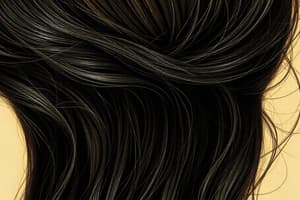Podcast
Questions and Answers
What condition is characterized by the absence of hair?
What condition is characterized by the absence of hair?
- Collagen dysplasia
- Hypotrichosis
- Epitheliogenesis Imperfecta
- Alopecia (correct)
Which of the following conditions makes animals more susceptible to bacterial and fungal infections?
Which of the following conditions makes animals more susceptible to bacterial and fungal infections?
- Epitheliogenesis Imperfecta
- Collagen dysplasia
- Photosensitization
- Hypotrichosis (correct)
What results from the failure of the stratified squamous epithelium to develop completely?
What results from the failure of the stratified squamous epithelium to develop completely?
- Alopecia
- Chemical Injury
- Photosensitization
- Epitheliogenesis Imperfecta (correct)
Which type of skin injury is caused by direct damage to the skin's endothelial cells?
Which type of skin injury is caused by direct damage to the skin's endothelial cells?
What is a common gross lesion associated with Type I photosensitization?
What is a common gross lesion associated with Type I photosensitization?
What can cause psychogenic dermatitis in animals?
What can cause psychogenic dermatitis in animals?
Which type of photosensitization is related to a failure in removing a metabolite of chlorophyll?
Which type of photosensitization is related to a failure in removing a metabolite of chlorophyll?
What is a characteristic of collagen dysplasia?
What is a characteristic of collagen dysplasia?
What is a common viral skin disease affecting sheep and goats?
What is a common viral skin disease affecting sheep and goats?
Which of the following is NOT a mode of entry for infectious agents into the skin?
Which of the following is NOT a mode of entry for infectious agents into the skin?
Which virus causes Foot and Mouth Disease (FMD)?
Which virus causes Foot and Mouth Disease (FMD)?
Which condition is characterized by vesicles and pustules on the skin?
Which condition is characterized by vesicles and pustules on the skin?
What type of virus is primarily involved in local viral skin infections?
What type of virus is primarily involved in local viral skin infections?
What is Scrapie more commonly known as?
What is Scrapie more commonly known as?
Which of the following diagnostic methods is NOT typically used for viral skin diseases?
Which of the following diagnostic methods is NOT typically used for viral skin diseases?
Which feature is characteristic of superficial pyoderma?
Which feature is characteristic of superficial pyoderma?
Study Notes
Types of Hair Loss
- Alopecia: Complete absence of hair.
- Hypotrichosis: Reduced hair amount, increasing susceptibility to sunburn and infections.
Connective Tissue Disorders
- Collagen Dysplasia: Characterized by hyper-extensibility and laxity of connective tissues.
Epitheliogenesis Imperfecta
- Incomplete development of stratified squamous epithelium affecting skin, adnexa, or oral mucosa.
Environmental Induced Skin Diseases
- Sun Injury: Caused by actinic (sun) damage and direct environmental factors.
- Chemical Injury: Local penetration through skin or systemic absorption leading to tissue damage.
- Physical Injury: Includes abrasions, lacerations, ulcerations, exposure to extremes in temperature, and foreign bodies.
Sunburn and Solar Dermatitis
- Caused by endothelial damage and keratinocyte injury, creating inflammatory responses.
- Acute Symptoms: Redness, pain, possible edema and blistering.
- Chronic Symptoms: Thickened inflamed skin, potential dysplasia or neoplasia; commonly affects ventral abdomen and thorax.
Photosensitization
- Activation of photodynamic substances leading to skin damage under UV-A or visible light.
- Type I: Exogenous agents, often from plants or drugs.
- Type II: Aberrant endogenous factors.
- Type III (Hepatogenous): Impaired removal of chlorophyll metabolites.
- Type IV: Unknown causes.
- Affects areas with poorly pigmented hair and skin.
Psychogenic Dermatitis
- Develops from persistent licking or chewing due to emotional or psychological stress.
- Common triggers include boredom, anxiety from environmental changes, or loss of companions.
Infectious Skin Diseases
- Categories include viral, bacterial, mycotic, parasitic, and protozoal skin diseases, with various entry routes including trauma, hair follicles, and skin glands.
Viral Skin Diseases
-
Local Infections: Mainly caused by poxviruses affecting multiple animal species.
- Contagious Pustular Dermatitis: Parapoxvirus affecting sheep and goats, can be fatal in young animals. Characterized by vesicles and crusts typically on lips.
-
Systemic Infections: Involves viruses like canine distemper and bovine viral diarrhea (BVD).
- Diagnosis includes clinical history, skin biopsy showing dermatitis, serology, and PCR.
Specific Viral Diseases
- Foot and Mouth Disease (FMD): A severe systemic viral infection impacting livestock.
- Papilloma Virus: Affects canine and bovine species, leading to verrucous lesions on skin.
Pyoderma
- Superficial Pyoderma: Presents as erythematous dermatitis with notable epidermal collarettes.
Studying That Suits You
Use AI to generate personalized quizzes and flashcards to suit your learning preferences.
Description
Explore various types of hair loss, including alopecia and hypotrichosis, alongside connective tissue disorders and environmental-induced skin diseases. Understand the mechanisms behind conditions like sunburn, chemical injuries, and epitheliogenesis imperfecta. Test your knowledge on dermatological health and its complexities.




